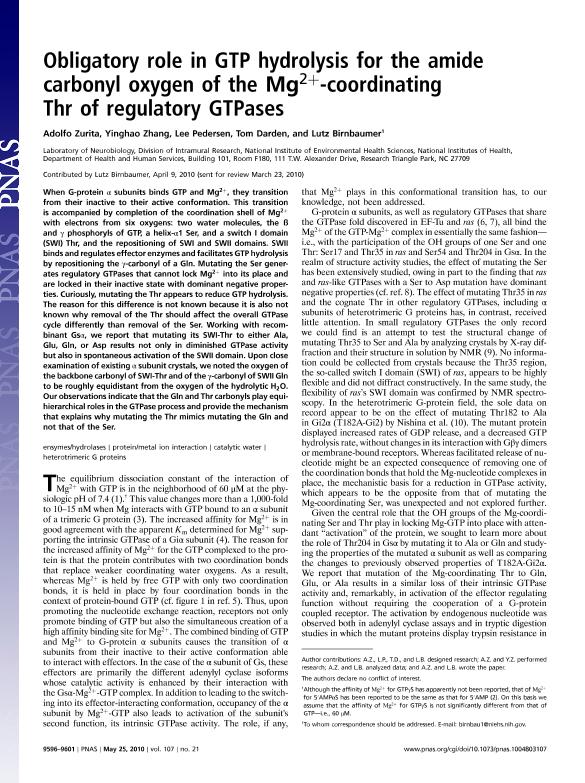Mostrar el registro sencillo del ítem
dc.contributor.author
Zurita, Adolfo Ramón

dc.contributor.author
Zhang, Yinghao
dc.contributor.author
Pedersen, Lee
dc.contributor.author
Darden, Tom
dc.contributor.author
Birnbaumer, Lutz
dc.date.available
2021-05-03T14:58:44Z
dc.date.issued
2010-05-25
dc.identifier.citation
Zurita, Adolfo Ramón; Zhang, Yinghao; Pedersen, Lee; Darden, Tom; Birnbaumer, Lutz; Obligatory role in GTP hydrolysis for the amide carbonyl oxygen of the Mg2+-coordinating Thr of regulatory GTPases; National Academy of Sciences; Proceedings of the National Academy of Sciences of The United States of America; 107; 21; 25-5-2010; 9596-9601
dc.identifier.issn
0027-8424
dc.identifier.uri
http://hdl.handle.net/11336/131252
dc.description.abstract
When G-protein α subunits binds GTP and Mg2+, they transition from their inactive to their active conformation. This transition is accompanied by completion of the coordination shell of Mg2+ with electrons from six oxygens: two water molecules, the β and γ phosphoryls of GTP, a helix-α1 Ser, and a switch I domain (SWI) Thr, and the repositioning of SWI and SWII domains. SWII binds and regulates effector enzymes and facilitates GTP hydrolysis by repositioning the γ-carbonyl of a Gln. Mutating the Ser generates regulatory GTPases that cannot lock Mg 2+ into its place and are locked in their inactive state with dominant negative properties. Curiously, mutating the Thr appears to reduce GTP hydrolysis. The reason for this difference is not known because it is also not known why removal of the Thr should affect the overall GTPase cycle differently than removal of the Ser. Working with recombinant Gsα, we report that mutating its SWI-Thr to either Ala, Glu, Gln, or Asp results not only in diminished GTPase activity but also in spontaneous activation of the SWII domain. Upon close examination of existing α subunit crystals, we noted the oxygen of the backbone carbonyl of SWI-Thr and of the γ-carbonyl of SWII Gln to be roughly equidistant from the oxygen of the hydrolytic H 2O. Our observations indicate that the Gln and Thr carbonyls play equihierarchical roles in the GTPase process and provide the mechanism that explains why mutating the Thr mimics mutating the Gln and not that of the Ser.
dc.format
application/pdf
dc.language.iso
eng
dc.publisher
National Academy of Sciences

dc.rights
info:eu-repo/semantics/openAccess
dc.rights.uri
https://creativecommons.org/licenses/by-nc-sa/2.5/ar/
dc.subject
CATALYTIC WATER
dc.subject
ENSYMES/HYDROLASES
dc.subject
HETEROTRIMERIC G PROTEINS
dc.subject
PROTEIN/METAL ION INTERACTION
dc.subject.classification
Bioquímica y Biología Molecular

dc.subject.classification
Ciencias Biológicas

dc.subject.classification
CIENCIAS NATURALES Y EXACTAS

dc.title
Obligatory role in GTP hydrolysis for the amide carbonyl oxygen of the Mg2+-coordinating Thr of regulatory GTPases
dc.type
info:eu-repo/semantics/article
dc.type
info:ar-repo/semantics/artículo
dc.type
info:eu-repo/semantics/publishedVersion
dc.date.updated
2021-04-09T16:16:43Z
dc.journal.volume
107
dc.journal.number
21
dc.journal.pagination
9596-9601
dc.journal.pais
Estados Unidos

dc.description.fil
Fil: Zurita, Adolfo Ramón. National Institutes of Health; Estados Unidos. Consejo Nacional de Investigaciones Científicas y Técnicas. Centro Científico Tecnológico Conicet - Córdoba; Argentina
dc.description.fil
Fil: Zhang, Yinghao. National Institutes of Health; Estados Unidos
dc.description.fil
Fil: Pedersen, Lee. National Institutes of Health; Estados Unidos
dc.description.fil
Fil: Darden, Tom. National Institutes of Health; Estados Unidos
dc.description.fil
Fil: Birnbaumer, Lutz. National Institutes of Health; Estados Unidos
dc.journal.title
Proceedings of the National Academy of Sciences of The United States of America

dc.relation.alternativeid
info:eu-repo/semantics/altIdentifier/url/https://www.pnas.org/content/107/21/9596.long
dc.relation.alternativeid
info:eu-repo/semantics/altIdentifier/doi/https://doi.org/10.1073/pnas.1004803107
Archivos asociados
